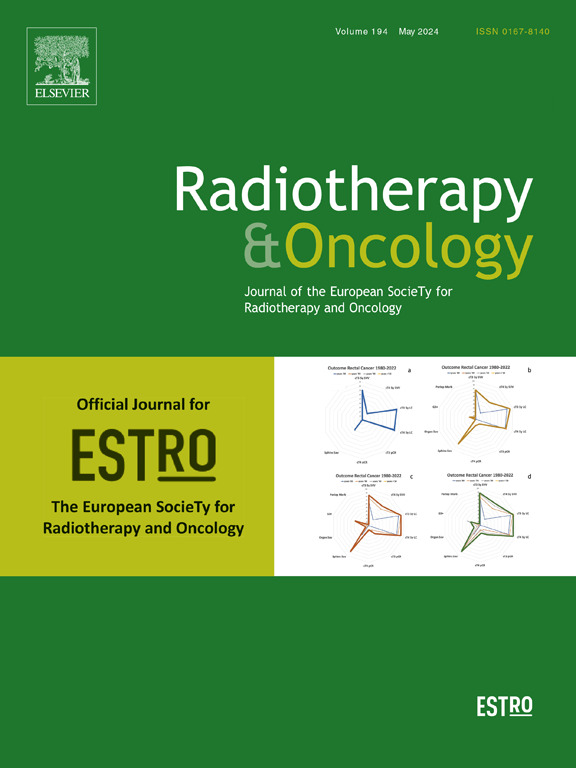Evaluation of radiation induced brain injury in nasopharyngeal carcinoma patients based on multi-parameter quantitative MRI: A prospective longitudinal study
IF 4.9
1区 医学
Q1 ONCOLOGY
引用次数: 0
Abstract
Purpose
Three dimensional pulsed continuous arterial spin labeling (3D-pCASL) and incoherent movement within voxels (IVIM) imaging was combined to assess dynamic microscopic structure changes of the hippocampus and temporal lobe white matter (TLWM) of nasopharyngeal carcinoma (NPC) patients post intensity-modulated radiation therapy (IMRT).
Methods
Forty-six patients who were first diagnosed with NPC and underwent IMRT were prospectively enrolled. 3D-CASL and IVIM were performed pre-RT, within 1 week (1 W) post-RT, 3 months (3 M) post-RT, 6 months (6 M) post-RT, and 18 months (18 M) post-RT. Twenty-seven patients completed follow-ups for all time periods, and their data were analyzed. The cerebral flow (CBF) derived from ASL, and apparent diffusion coefficient (ADC), pure diffusion coefficient (D), pseudo-diffusion coefficient (D*), and perfusion fraction (F) derived from IVIM of hippocampus and TLWM were analyzed. The quantitative parameters were measured before RT as the baseline, and the corresponding parameter values and change rates at each time point post-RT were compared using the non-parametric Wilcoxon rank sum test.
Results
At 1 W post-RT, CBF showed a significant increase and peaked in both the hippocampus and TLWM (p < 0.05) with change rate of 30.3 % and 24.1 %. In the hippocampus, both D and D* were significantly increased from pre-RT to 6 M post-RT with change rate of 6.66 % and 34.7 %, while D*-values remained significantly higher than pre-RT at 12 months post-RT with change rate of 41.2 %. In the TLWM, the F firstly increased and then decreased, and was significantly decreased from pre-RT to 6 M post-RT with change rate of 20.2 %.
Conclusion
3D-PCASL and IVIM can indirectly reflecting the developmental pattern and molecular mechanism of RT induced brain injury.
基于多参数定量磁共振成像的鼻咽癌患者辐射诱导脑损伤评估:前瞻性纵向研究
目的:结合三维脉冲连续动脉自旋标记(3D-pCASL)和体素内非相干运动(IVIM)成像,评估鼻咽癌(NPC)患者接受调强放射治疗(IMRT)后海马和颞叶白质(TLWM)的动态微观结构变化:方法: 对首次确诊为鼻咽癌并接受了 IMRT 的 46 名患者进行了前瞻性研究。分别在放疗前、放疗后 1 周内、放疗后 3 个月、放疗后 6 个月和放疗后 18 个月进行了 3D-CASL 和 IVIM 检查。27 名患者完成了所有时间段的随访,并对其数据进行了分析。分析了 ASL 导出的脑血流(CBF)、海马和 TLWM IVIM 导出的表观扩散系数(ADC)、纯扩散系数(D)、伪扩散系数(D*)和灌注分数(F)。定量参数以 RT 前为基线,采用非参数 Wilcoxon 秩和检验比较 RT 后各时间点的相应参数值和变化率:结论:3D-PCASL和IVIM可间接反映RT诱导脑损伤的发育模式和分子机制。
本文章由计算机程序翻译,如有差异,请以英文原文为准。
求助全文
约1分钟内获得全文
求助全文
来源期刊

Radiotherapy and Oncology
医学-核医学
CiteScore
10.30
自引率
10.50%
发文量
2445
审稿时长
45 days
期刊介绍:
Radiotherapy and Oncology publishes papers describing original research as well as review articles. It covers areas of interest relating to radiation oncology. This includes: clinical radiotherapy, combined modality treatment, translational studies, epidemiological outcomes, imaging, dosimetry, and radiation therapy planning, experimental work in radiobiology, chemobiology, hyperthermia and tumour biology, as well as data science in radiation oncology and physics aspects relevant to oncology.Papers on more general aspects of interest to the radiation oncologist including chemotherapy, surgery and immunology are also published.
 求助内容:
求助内容: 应助结果提醒方式:
应助结果提醒方式:


